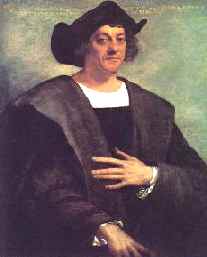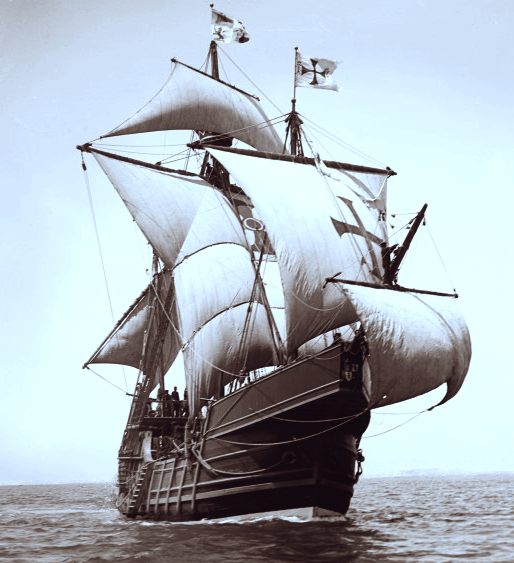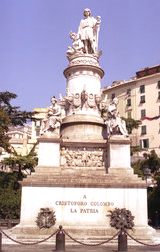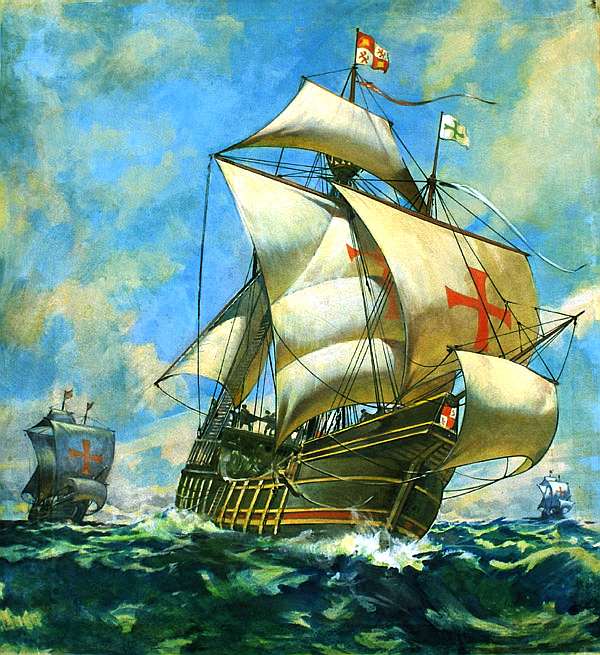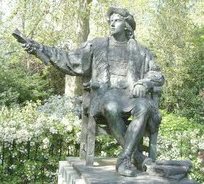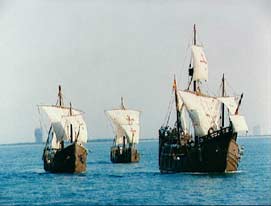|
THE VOYAGES OF CHRISTOPHER COLUMBUS - 1451 to 1506
|
||||||||
|
HOME | BIOLOGY | BOOKS | FILMS | GEOGRAPHY | HISTORY | INDEX | INVESTORS | MUSIC | NEWS | SOLAR BOATS | SPORT |
||||||||
|
Christopher Columbus was born in 1451 Calvi (Corsica), northwest of the island, 200km from Ajaccio. He was the oldest of five children. As a child, he helped his father as a weaver. He always liked the sea. Genoa was an important seaport. There is no doubt that as a child he caught rides on ships. He had little schooling but was a genius with the sea. His plan was not to prove that the world was flat, but it was to find a shortcut to the Spice Islands. He wanted to establish a city there for trade, seaports, and much more. When he grew into a man he was interested in sailing to Asia by going west. First he went to the king of Italy and presented his idea before him. Italy wasn't looking for a way to Asia, they were still receiving riches from their old trade routes. His three ships were the Santa Maria, the Nina, and the Pinta.
Christopher Columbus
Some Facts About Christopher Columbus
Man of Mystery
After five centuries, Columbus remains a mysterious and controversial figure who has been variously described as one of the greatest mariners in history, a visionary genius, a mystic, a national hero, a failed administrator, a naive entrepreneur, and a ruthless and greedy imperialist.
Columbus's enterprise to find a westward route to Asia grew out of the practical experience of a long and varied maritime career, as well as out of his considerable reading in geographical and theological literature. He settled for a time in Portugal, where he tried unsuccessfully to enlist support for his project, before moving to Spain. After many difficulties, through a combination of good luck and persuasiveness, he gained the support of the Catholic monarchs, Isabel and Fernando.
The widely published report of his voyage of 1492 made Columbus famous throughout Europe and secured for him the title of Admiral of the Ocean Sea and further royal patronage. Columbus, who never abandoned the belief that he had reached Asia, led three more expeditions to the Caribbean. But intrigue and his own administrative failings brought disappointment and political obscurity to his final years.
Defense of Privileges
Queen Isabel and King Fernando had agreed to Columbus's lavish demands if he succeeded on his first voyage: he would be knighted, appointed Admiral of the Ocean Sea, made the viceroy of any new lands, and awarded ten percent of any new wealth. By 1502, however, Columbus had every reason to fear for the security of his position. He had been charged with maladministration in the Indies.
The Library's vellum copy of the Book of Privileges is one of four that Columbus commissioned to record his agreements with the Spanish crown. It is unique in preserving an unofficial transcription of a Papal Bull of September 26, 1493 in which Pope Alexander VI extended Spain's rights to the New World.
Much concerned with social status, Columbus was granted a coat of arms in 1493. By 1502, he had added several new elements, such as an emerging continent next to islands and five golden anchors to represent the office of the Admiral of the Sea.
As a reward for his successful voyage of discovery, the Spanish sovereigns granted Columbus the right to bear arms. According to the blazon specified in letters patent dated May 20, 1493, Columbus was to bear in the first and the second quarters the royal charges of Castile and Leon -- the castle and the lion -- but with different tinctures or colors. In the third quarter would be islands in a wavy sea, and in the fourth, the customary arms of his family.
Columbus Coat of Arms
The earlist graphic representation of Columbus's arms is found in his Book of Privileges and shows the significant modifications Columbus ordered by his own authority. In addition to the royal charges that were authorized in the top quarters, Columbus adopted the royal colors as well, added a continent among the islands in the third quarter, and for the fourth quarter borrowed five anchors in fess from the blazon of the Admiral of Castille. Columbus's bold usurpation of the royal arms, as well as his choice of additional symbols, help to define his personality and his sense of the significance of his service to the Spanish monarchs.
The Book of Privileges is a collection of agreements between Columbus and the crowns of Spain prepared in Seville in 1502 before his 4th final voyage. The compilation of documents includes the 1497 confirmation of the rights to titles and profits granted to the Admiral by the 1492 contract of Santa Fe and augmented in 1493 and 1494, as well as routine instructions and authorizations related to his third voyage. We know that four copies of his Book of Privileges existed in 1502, three written on vellum and one on paper.
All three vellum copies have thirty-six documents in common, including the Papal Bull inter caetera of May 4, 1493, defining the line of demarcation of future Spanish and Portuguese explorations, and specifically acknowledging Columbus's contributions. The bull is the first document on vellum in the Library's copy and the thirty-sixth document in the Genoa and the Paris codices. The Library copy does not have the elaborate rubricated title page, the vividly colored Columbus coat of arms, or the authenticating notarial signatures contained in the other copies. The Library's copy, however, does have a unique transcription of the Papal Bull Dudum siquidem of September 26, 1493, extending the Spanish donation. The bull is folded and addressed to the Spanish sovereigns.
Christopher Columbus (1451 – 20 May 1506) (Cristoforo Colombo in Italian, Cristóbal Colón in Spanish, Cristóvão Colombo in Portuguese) was most probably Genoese, although some historians claim he could have been born in other places, from the Crown of Aragó to the Kingdoms of Galicia or Portugal among others. He was an explorer and trader who crossed the Atlantic Ocean and reached the Americas on October 12th 1492 under the flag of Castilian Spain. He believed that the earth was a relatively small sphere, and argued that a ship could reach the Far East via a westward course. Contrary to the somewhat widespread notion that Columbus fought with opposition based on the idea that the earth was flat, it was fairly well accepted at that time that the earth was a spherical body. What the main debate was over was whether or not it would be possible to get around it without running out of food or getting stuck in windless regions. Although his explorations were not the first to reach the Americas, they inaugurated permanent contact between the New and Old Worlds.
Columbus was not the first European to reach the continent. It is widely acknowledged today that Scandinavians had travelled to North America from Greenland in the 11th century and set up a short-lived colony at L'Anse aux Meadows. There is speculation that an obscure mariner travelled to the Americas before Columbus and provided him with sources for his claims. There are also many theories of expeditions to the Americas by a variety of peoples throughout time; see Pre-Columbian trans-oceanic contact, one of the most consistent is the first exploration (before 1472) of two, led by João Vaz Corte-Real to Terra Verde (today's Newfoundland). Giovanni Caboto (better known as John Cabot) was first to reach the American mainland (which Columbus did not reach until his third voyage). However, there is one thing that sets off Columbus' first voyage from all of these: less than two decades later, the existence of America was known to the general public throughout Europe.
Columbus landed in the Bahamas and later explored much of the Caribbean, including the isles of Juana (Cuba) and Espanola (Hispaniola), as well as the coasts of Central and South America. He never reached the present-day U.S.A., although he is generally regarded as the first European to reach "America", and "Columbus Day" (12 October, the anniversary of Columbus' landing in the Bahamas) is celebrated as a holiday.
Unlike the voyage of the Scandinavians, Columbus's voyages led to a relatively quick, general and lasting recognition of the existence of the New World by the Old World, the Columbian Exchange of species (both those harmful to humans, such as viruses, bacteria, and parasites, and beneficial to humans, such as tomatoes, potatoes, maize, and horses), and the first large-scale colonization of the Americas by Europeans. The voyages also inaugurated ongoing commerce between the Old and New Worlds, thus providing the basis for globalization. Columbus remains a controversial figure. Some – including many Native Americans – view him as responsible, directly or indirectly, for the deaths of tens, if not hundreds, of millions of indigenous peoples, exploitation of the Americas by Europe, and slavery in the West Indies. Others honour him for the massive boost his discoveries gave to Western expansion and culture. Italian Americans hail Columbus as an icon of their heritage.
Columbus' signature prior to 1492
It has generally been accepted that he was Genovese, although doubts have persistently been voiced regarding this. His name in Italian is Cristoforo Colombo ,in Spanish is Cristóbal Colón, in Catalan it is Cristòfor Colom and in Portuguese Cristóvão Colombo. Columbus is a Latinized form of his surname. The Latin roots of his name can be translated "Christ-bearer, Dove". Columbus' signature reads Xpo ferens ("Bearing Christ").
Columbus claimed governorship of the new territories (by prior agreement with the Spanish monarchs) and made several more journeys across the Atlantic. While regarded by some as an excellent navigator, he was seen by many contemporaries as a poor administrator and was stripped of his governorship in 1500.
Early life
There are various versions of Columbus's origins and life before 1476. The account that has traditionally been supported by most historians is as follows:
Columbus was born between August 26 and October 31 in the year 1451, in the Italian port city of Genoa. His father was Domenico Colombo, a woollens merchant, and his mother was Susanna Fontanarossa, the daughter of a woollens merchant. Christopher had three younger brothers, Bartolomeo, Giovanni Pellegrino, and Giacomo, and a sister, Bianchinetta.
Columbus monument in Genoa
In 1470, the family moved to Savona, where Christopher worked for his father in wool processing. During this period he studied cartography with his brother Bartolomeo. Christopher received almost no formal education; a voracious reader, he was largely self-taught.
In 1474, Columbus joined a ship of the Spinola Financiers, who were Genoese patrons of his father. He spent a year on a ship bound towards Khios (an island in the Aegean Sea) and, after a brief visit home, spent a year in Khios. It is believed that this is where he recruited some of his sailors.
A 1476, commercial expedition gave Columbus his first opportunity to sail into the Atlantic Ocean. The fleet came under attack by French privateers off the Cape of St. Vincent. Columbus's ship was burned and he swam six miles to shore.
By 1477, Columbus was living in Lisbon. Portugal had become a center for maritime activity with ships sailing for England, Ireland, Iceland, Madeira, the Azores, and Africa. Columbus's brother Bartolomeo worked as a mapmaker in Lisbon. At times, the brothers worked together as draftsmen and book collectors.
He became a merchant sailor with the Portuguese fleet, and sailed to Iceland via Ireland in 1477, to Madeira in 1478 to purchase sugar, and along the coasts of West Africa between 1482 and 1485, reaching the Portuguese trade post São Jorge da Mina at the Guinea coast.
Columbus married Felipa Perestrello Moniz, a daughter from a noble Portuguese family with some Italian ancestry, in 1479. Felipa's father, Bartolomeu Perestrelo, had partaken in the discovery of the Madeira Islands and owned one of them (Porto Santo Island), but died when Felipa was a baby, leaving his second wife a wealthy widow. As part of his dowry, the mariner received all of Perestello's charts of the winds and currents of the Portuguese possessions of the Atlantic. Columbus and Felipa had a son, Diego Colón in 1480. Felipa died in January of 1485. Columbus later found a lifelong partner in Spain, an orphan named Beatriz Enriquez. She was living with a cousin in the weaving industry of Córdoba. They never married, but Columbus left Beatriz a rich woman and directed Diego to treat her as his own mother. The two had a son, Ferdinand in 1488. Both boys served as pages to Prince Juan, son of Ferdinand and Isabella, and each later contributed, with fabulous success, to the rehabilitation of their father's reputation.
The idea
Christian Europe, long allowed safe passage to India and China (sources of valued trade goods such as silk and spices) under the hegemony of the Mongol Empire (Pax Mongolica, or "Mongol peace"), was now, after the fragmentation of that empire, under a complete economic blockade by Muslim states. In response to Muslim hegemony on land, Portugal sought an eastward sea route to the Indies, and promoted the establishment of trading posts and later colonies along the coast of Africa. Columbus had another idea. By the 1480s, he had developed a plan to travel to the Indies (then roughly meaning all of south and east Asia) by sailing west across the Ocean Sea (the Atlantic Ocean) instead.
It is sometimes claimed that the reason Columbus had a hard time receiving support for this plan was that Europeans believed that the Earth was flat. This myth can be traced to Washington Irving's novel The Life and Voyages of Christopher Columbus (1828).
The fact that the Earth is round was evident to most people of Columbus's time, especially other sailors and navigators (Eratosthenes (276-194 BC) had in fact accurately calculated the circumference of the Earth). The problem was that the experts did not agree with his estimates of the distance to the Indies. Most scholars accepted Ptolemy's claim that the terrestrial landmass (for Europeans of the time, Eurasia and Africa) occupied 180 degrees of the terrestrial sphere, leaving 180 degrees of water. In fact, it occupies about 120 degrees, leaving 60 degrees unaccounted for at that time.
Columbus accepted the calculations of Pierre d'Ailly, that the land-mass occupied 225 degrees, leaving only 135 degrees of water. Moreover, Columbus believed that one degree actually covered less space on the earth's surface than commonly believed. Finally, Columbus read maps as if the distances were calculated in Roman miles (1524 meters or 5,000 feet) rather than nautical miles (1853.99 meters or 6,082.66 feet at the equator). The true circumference of the earth is about 40,000 km (24,900 statute miles of 5,280 feet each), whereas the circumference of Columbus's earth was the equivalent of at most 19,000 modern statue miles (or 30,600 km). Columbus calculated that the distance from the Canary Islands to Japan was 2,400 nautical miles (about 4,444 km).
In fact, the distance is about 10,600 nautical miles (19,600 km), and most European sailors and navigators concluded that the Indies were too far away to make his plan worth considering. They were right and Columbus was wrong – but, ultimately in his case, like in that of so many successful individuals, initiative and enterpreneurship ended up being more important than factual accuracy.
Columbus statue Belgrave Square, London
Columbus lobbies for funding
Columbus first presented his plan to the court of Portugal in 1485. The king's experts believed that the route would be longer than Columbus thought (the actual distance is even longer than the Portuguese believed), and denied Columbus's request. It is probable that he made the same outrageous demands for himself in Portugal that he later made in Spain, where he went next. He tried to get backing from the monarchs of Aragon and Castile, Ferdinand of Aragon and Isabella of Castile, who, by marrying, had united the largest kingdoms of Spain and were ruling them together.
After seven years of lobbying at the Spanish court, where he was kept on a salary to prevent him from taking his ideas elsewhere, he was finally successful in 1492. Ferdinand and Isabella had just conquered Granada, the last Muslim stronghold on the Iberian peninsula, and they received Columbus in Córdoba (in the monarchs' Alcázar or castle). Isabella finally turned Columbus down on the advice of her "think tank" and he was leaving town in despair when Ferdinand lost his patience. Isabella sent a royal guard to fetch him and Ferdinand later rightfully claimed credit for being "the principal cause why those islands were discovered."
About half of the financing was to come from private Italian investors, which Columbus had already lined up. Financially broke from the Granada campaign, the monarchs left it to the royal treasurer to shift funds among various royal accounts on behalf of the enterprise. Columbus was to be made Admiral of the Ocean Sea and granted an inheritable governorship to the new territories he would discover, as well as a portion of all profits. The terms were absurd, but his own son later wrote that the monarchs really didn't expect him to return.
|
The language of Columbus
Although Genoese documents have been found about a weaver named Colombo, it has also been noted that, in the preserved documents, Columbus wrote almost exclusively in Castilian, and that he used the language, with Portuguese phonetics, even when writing personal notes to himself, to his brother, Italian friends, and to the Bank of Genoa.
There is a small handwritten Genoese gloss in an Italian edition of the History of Plinius that he read in his second voyage to America. However, it displays both Castilian and Portuguese influences. Genoese Italian was not a written language in the 15th century, but one would expect a better transliteration into this dialect from a native speaker. However, many people become "tongue-tied" when using what is to them an intimate childhood language. There is also a note in non-Genoese Italian in his own Book of Prophesies exhibiting, according to historian August Kling, "characteristics of northern Italian humanism in its calligraphy, syntax, and spelling." Columbus took great care and pride in writing this form of Italian.
Phillips and Phillips point out that five hundred years ago, the Latinate languages had not distanced themselves to the degree they have today. Bartolomé de las Casas in his Historia de las Indias explained that Columbus did not know Castilian well and that he was not born in Castile. In his letters he refers to himself frequently, if cryptically, as a "foreigner." Ramón Menéndez Pidal studied the language of Columbus in 1942, suggesting that while still in Genoa, Columbus learned notions of Portugalized Spanish from travelers, who used a sort of commercial Latin or lingua franca (latín ginobisco for Spaniards). He suggests that Columbus learned Spanish in Portugal through its use in Portugal as or "adopted language of culture" from 1450. This same Spanish is used by poets like Fernán Silveira and Joan Manuel.
The first testimony of his use of Spanish is from the 1480s. Pidal and many others detect a lot of Portuguese in his Spanish, where he mixes, for example, falar and hablar. But Pidal does not accept the hypothesis of a Galician origin for Columbus by noting that where Portuguese and Galician diverged, Columbus always used the Portuguese form. Pidal doubts that Columbus could ever tell Portuguese and Spanish apart, which is why he did not make the effort to learn them properly. Latin, on the other hand, was the language of scholarship, and here Columbus excelled. He also kept his journal in Latin, and a "secret" journal in Greek.
According to historian Charles Merrill, analysis of his handwriting indicates that it is typical of someone who was a native Catalan, and Columbus's phonetic mistakes in Castilian are "most likely" those of a Catalan. Also, that he married a Portuguese noblewoman is presented as evidence that his origin was of nobility rather than the Italian merchant class, since it was unheard of during his time for nobility to marry outside their class. This same theory suggests he was the illegitimate son of a prominent Catalan sea-faring family, which had served as mercenaries in a sea battle against Castilian forces. Fighting against Ferdinand and being illegitimate were two excellent reasons for keeping his origins obscure. Furthermore, the disinternment of his brother's body shows him to be a different age, by nearly a decade, than the "Bartolome Colombo" of the Genoese family.
Perceptions of Columbus
Christopher Columbus has had a cultural significance beyond his actual achievements and actions as an individual; he also became a symbol, a figure of legend. The mythology of Columbus has cast him as an archetype for both good and for evil.
The casting of Columbus as a figure of "good" or of "evil" often depends on people's perspectives as to whether the arrival of Europeans to the New World and the introduction of Christianity or the Roman Catholic faith is seen as positive or negative.
Columbus as a hero
Traditionally, Columbus is viewed as a man of heroic stature by the European-descended population of the New World. He has often been hailed as a man of heroism and bravery, and also of faith: he sailed westward into mostly unknown waters, and his unique scheme is often viewed as ingenious. He "set an example for us all by showing what monumental feats can be accomplished through perseverance and faith" (George H. W. Bush, June 8, 1989).
Hero worship of Columbus perhaps reached its zenith around 1892, the 400th anniversary of his first arrival in the Americas. Monuments to Columbus were erected throughout the United States and Latin America, extolling him as a hero. The myth that Columbus thought the world round while his contemporaries believed in a flat earth was often repeated. This tale was used to show that Columbus was enlightened and forward looking. Columbus's defiance of convention in sailing west to get to the far east was hailed as a model of "American"-style can-do inventiveness.
In the United States, the admiration of Columbus was particularly embraced by some members of the Italian American, Hispanic, and Catholic communities. These groups point to Columbus as one of their own to show that Mediterranean Catholics could and did make great contributions to the USA. The modern vilification of Columbus is seen by his supporters and by many scholars as being politically motivated and non-historical.
Columbus as a villain
Much criticism focuses on the continuing positive Columbus myths and celebrations (such as Columbus Day) and their effects on American thought towards present-day Native Americans. Official celebrations of the 500th anniversary of Columbus's first voyage in 1992 were muted, and demonstrators protested marking the anniversary at all. It was in this spirit that Venezuelan President Hugo Chávez signed, in October, 2002, a decree changing the name of Venezuela's "Columbus Day" to "The Day of Indigenous Resistance" in honor of the nation's indigenous groups. On October 12, 2004, supporters of Chávez destroyed a 100-year old statue of Columbus in Caracas. They did this because they found Columbus guilty of 'imperialist genocide'. They blotted the statue with slogans like 'Columbus=Bush'. (For more, see Columbus Day.) The genocide and atrocious acts committed by the Spanish against the natives (the Tainos in particular) are well documented in terrifying detail in the letters of Bartelome de Las Casas.
|
COLUMBUS NAVIGATION
Columbus and dead reckoning navigation. Columbus and celestial navigation. How long was Columbus's league? Columbus and longitude. Columbus's ships. Columbus's crew.
|
COLUMBUS HISTORY
A Columbus Timeline. The First Voyage, 1492-1493. The Second Voyage, 1493-1496. The Third Voyage, 1498-1500. The Fourth Voyage, 1502-1504.
|
MORE CHRISTOPHER COLUMBUS LINKS (Tom Tirado's)
-
Columbus and Madeira (there is also a Portuguese version)
-
Information, got from the 'Archive of the Indies'.
-
Common myths about Columbus and the most current facts to counter them.
-
Motivations to reach the Indies (undergraduate paper)
-
Columbus the Man - psychology
-
...and many other articles, especially about the 1492-1992 Quincentennial and the so-called Columbus debate.
1492: An ongoing voyage - Library of Congress Exhibit
Other general pages:
-
Christopher Columbus - Encarta Online article by Tom Tirado. Extensive description of Columbus's life, voyages and place in history.
-
The True Story of Christopher Columbus, Called the Great Admiral - an 1892 biography of Columbus for youths
-
The Life of Christopher Columbus - another 19th century biography
-
Columbus Day - links
-
Christopher Columbus and the Spanish Empire (University of Calgary)
-
Christoph Kolumbus (in German)
-
Christophe Colomb - Le Grand Admiral (in French)
-
Die Entdeckung Amerikas (in German)
-
Christopher Columbus - Early career and first voyage - biography upto and including the first voyage from Britannica Online
Who was Columbus?
Although most historians believe Columbus's own claims that he was from Genova, there are others who think that he was hiding his true descent or past. Of those the one that is most prevalent at present is the theory that he was a converted Jew. Hate against Jews was high in those days, in fact they were expelled from Spain in 1492, and converted Jews would be suspect as well.
-
A Critical Study on the Origin of Christopher Columbus - extensive discussion on the controversies around Columbus's descent and youth.
-
Should Columbus' First Carta de las Indias Count as a Work of Catalan Letters? - arguing for a Catalan Columbus
-
Columbus's Medinah? - arguing for a Jewish descent
-
Uncovering the Real Columbus - contains a more traditional theory about Columbus's descent.
Before 1492:
-
Uncovering the Real Columbus - excerpts from a book by John B. Wolcott
Navigation Methods
During his voyages, Columbus probably mostly relied on dead reckoning. Here the course and speed of the ship are estimated or measured, and from this the course is found. See this page on the Columbus navigation homepage for more information. This theory is supported in an article by Douglas Peck. On the other hand, Arne Molander argues that Columbus used the old tradition of latitude sailing, in which one sails straight west (or east) from a point of known latitude. Other articles about Columbus' navigation methods:
First voyage:
-
Archaeologists probably found La Navidad, Columbus's first colony in the new world (another article)
First landing:
General articles
-
The Columbus Landfall Homepage (author Keith Pickering)
-
Columbus's First Landfall - overview
-
Columbus's First Landfall. Large. The author supports Guanahani, but the other hypotheses are also mentioned.
The evidence
-
Evidence from Las Casa's logbook
-
Attempt to reconstruct the 1492 coastlines
The proposals
-
Samana Cay: pro: Joseph Judge, neutral: Columbus Landfall homepage, contra: New York times article
-
Watling Island (also known as Guanahani or San Salvador): pro: William Keegan, Kim Gainer, contra: Columbus Landfall Homepage, Joseph Judge - map
-
Conception Island: Joanne Dumene, Columbus Landfall Homepage
-
Plana Cays: Keith Pickering, Columbus Landfall Homeapge (also by Keith Pickering) - map
-
Lignum Vitae Cay: Intelligencer Journal article, Columbus Landfall Homepage
-
Egg Island: Columbus Landfall Homepage, Arne Molander
-
Grand Turk: Columbus Landfall Homepage, H.E. Sadler
-
Virgin Islands: pro: John Dyson, contra: Joseph Judge, Columbus Landfall Homepage
Second voyage:
-
Archeological investigations of La Isabela, Columbus's colony.
Third voyage:
Fourth voyage:
-
Searching for the shipwreck of the 'Gallega'.
Primary Sources:
These are (transcripts of) original documents about Columbus and his voyages:
-
Priviledges and Prerogatives Granted by Their Catholic Majesties to Christopher Columbus (1492)
-
Journal (extractts)
-
Letter to the king and queen of Spain (1494?) (alternative site)
-
Epistola de insulis nuper inventis (original 1494 print shown in reproduction, transcription and translation) (alternative site)
Other people:
Pictures:
-
Looks Are Deceiving: the Portraits of Christopher Columbus. Attempting to get a picture of Columbus by combining various portraits. Links to various pictures.
-
Portrait by Sebastiano del Piombo
-
Columbus leaving Palos by Joaquin Sorolla y Bastida
-
The Pinta and Santa Maria (replicas)
-
Replicas of the Nina, the Pinta and the Santa Maria
-
Guanahani (a discussion of the candidates for site of first landing)
-
Pharaoh (historical novel by Bolesław Prus, incorporating a solar eclipse scene likely inspired by Columbus' exploitation of a lunar eclipse).
References
-
Jack Forbes, Columbus and Other Cannibals, Autonomedia, 1992.
-
Samuel Eliot Morison, Admiral of the Ocean Sea: A Life of Christopher Columbus, Little, Brown and Company, 1991, trade paperback, 680 pages, ISBN 0316584789 (9 other editions available both in hardback and paperback). A biography sympathetic to Columbus, though not blind to violent acts by Columbus and his crew
-
Brian Fagan: Clash of the Cultures, AltaMira Press 1997. Presents a less-favorable view.
-
Felipe Fernández-Armesto: Columbus, Oxford University Press 1991. Scholarly work, careful to support all statements with sources.
-
Sherburn Cook and Woodrow Borah: Essays in Population History Volume I, University of California Press, 1971
-
John Noble Wilford and Ashbel Green, The mysterious history of Columbus :an exploration of the man, the myth, the legacy, Knopf, 1991, hardcover: ISBN 0679404767, trade paperback: ISBN 0679738320. John Noble Green(?) is a science editor at the New York Times.
-
J.M. Cohen: "The Four Voyages of Christopher Columbus: Being His Own Log-Book, Letters and Dispatches With Connecting Narrative Drawn from the Life of the Admiral by His Son Hernando Colon and Others", Penguin Classics, 1992.
-
Michael H. Hart, The 100, Carol Publishing Group, July 1992, paperback, 576 pages, ISBN 0806513500
-
James Loewen. "Lies My Teacher Told Me: Everything Your American History Textbook Got Wrong". New Press, 1995.
-
Crosby, Alfred W. The Colubmian Voyages. the Columbian Exchange, and Their Historians. Washington, DC: American Historical Association, 1987. ED 303 417.
-
A Finger in the Wound : Body Politics in Quincentennial Guatemala, ISBN 0520212843
-
Turner, Jack. "Spice - The History of a Temptation", Random House, 2004 ISBN 0-375-40721-9.
-
Mascarenhas Barreto, "The Portuguese Columbus: Secret Agent of King John II", 1992, ISBN 0312079486
MARITIME HISTORY
|
FIRST SOLAR PACIFIC NAVIGATION
|
HMS ENDURANCE
|
SIR HENRY MORGAN (Admiral)
|
GENERAL HISTORY
|
D DAY OPERATION NEPTUNE 6th June 1944 HERSTMONCEUX CASTLE - MEDIEVAL HISTORY
|
THE AMERICAN WAR OF INDEPENDENCE
|
![]()
Christopher Columbus would have approved
A heartwarming adventure: Pirate whalers V conservationists
with a $billion dollars riding on the outcome.
This website is Copyright © 1999 & 2012 Electrick Publications. The bird logos and name Solar Navigator are trademarks.
The name '1824' is a trade mark of Solar Cola Ltd. All rights reserved. Max Energy Limited is an educational charity.
AUTOMOTIVE | BLUEPLANET | ELECTRIC CARS | ELECTRIC CYCLES | SOLAR CARS | SOLARNAVIGATOR | UTOPIA
